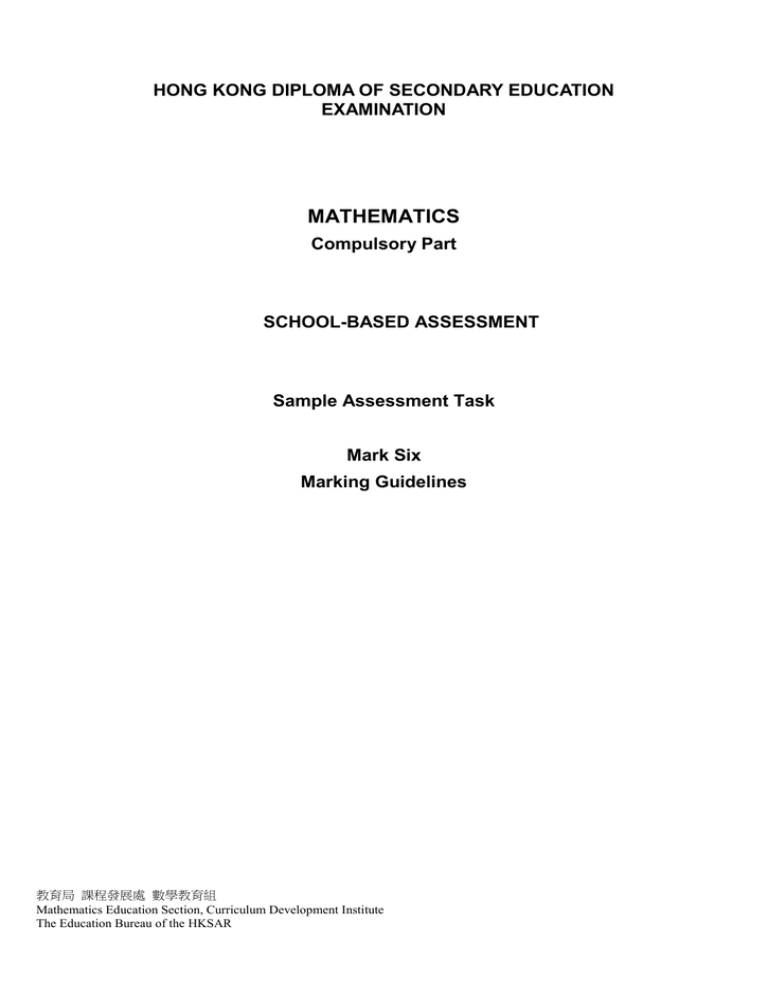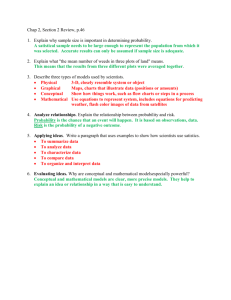MATHEMATICS
advertisement

HONG KONG DIPLOMA OF SECONDARY EDUCATION EXAMINATION MATHEMATICS Compulsory Part SCHOOL-BASED ASSESSMENT Sample Assessment Task Mark Six Marking Guidelines 教育局 課程發展處 數學教育組 Mathematics Education Section, Curriculum Development Institute The Education Bureau of the HKSAR Assessment Scale The assessment scale for tasks on Data Handling is shown in the following table. Level of Marks Performance Very good Good Fair Weak Mathematical Knowledge and Data Handling Skills The student demonstrates a complete understanding of the underlying mathematical knowledge and data-handling skills which are relevant to the task, and is consistently 13–16 competent and accurate in applying them in handling the task. Typically, the student can use statistical measures or charts to present data. The student interprets the results reasonably and critically, and evaluates the results. 9–12 The student demonstrates a substantial understanding of the underlying mathematical knowledge and data-handling skills which are relevant to the task, and is generally competent and accurate in applying them in handling the task. Typically, the student uses statistical measures or charts to present data and interprets the results reasonably. 5–8 The student demonstrates a basic understanding of the underlying mathematical knowledge and data-handling skills which are relevant to the task, and is occasionally competent and accurate in applying them in handling the task. Typically, the student attempts to use statistical measures or charts to present data and attempts to interpret the results. 1–4 The student demonstrates a limited understanding of the underlying mathematical knowledge and data-handling skills which are relevant to the task, and is rarely competent and accurate in applying them in handling the task. Typically, the student attempts to use statistical measures or charts to present data. Marks Mathematical Communication Skills 4 The student communicates ideas in a clear, well organised and logically valid manner through coherent written/verbal accounts, using appropriate forms of mathematical presentation to compare and analyse statistical data in making decisions. 3 The student is able to communicate ideas properly through written/verbal accounts, using appropriate forms of mathematical presentation such as statistical terminology, diagrams, tables and charts to present and interpret statistical data. 2 1 The student is able to communicate ideas with some appropriate forms of mathematical presentation such as statistical terminology, diagrams, tables, charts etc. The student attempts to communicate ideas using mathematical symbols and notations, diagrams, tables, charts etc., but with limited success. ‧ The full mark of a SBA task on Data Handling submitted should be scaled to 20 marks, of which 16 marks are awarded for the mathematical knowledge and Data Handling skills while 4 marks are awarded for the communication skills. ‧ Teachers should base on the above assessment scale to design SBA tasks for assessing students with different abilities and to develop the marking guidelines. Mark Six_Marking Guidelines 2 Marking Guidelines Solution Performance Part A 1. (a) Evidence: Answers to the questions There are 4 (or 4 C3 ) combinations, namely ABC, ABD, ACD and BCD n! (or nCr ) r !( n r )! Answer all the questions wrongly Fair: Answer 1 question correctly Good: Answer 2 questions correctly (b) The number of possible combinations are (c) 1 The probability = nCr Very good: Answer all questions correctly (a) 49 C 6 Evidences: (i) The answer (ii) The proofs (b) P(winning the First Prize) Part B 2. Weak: 1 49 C6 1 = 13983816 = 6 C5 P(winning the Second Prize) = = Weak: The answer for (a) is incorrect and either (b) is left blank or the method of proving (b) is incorrect Fair: The answer for (a) is correct, but the method of proving (b) is incorrect Good: The answer for (a) is correct, and the method of proving (b) is partly correct 49 C6 1 2330636 Very good: The answer for (a) is correct and the proofs for (b) are correctly done (c) (i) P(winning the Third Prize) = 6 C5 42 C1 Evidence: Answers to the questions 49 C6 Weak: Answer all the questions wrongly Fair: Answer 1 question correctly Good: Answer all the questions correctly 0.00001802 (ii) P(winning the Sixth Prize) = 6 C3 42 C2 49 C6 0.001231 Mark Six_Marking Guidelines Very Good: Answer all the questions correctly with valid working 3 Marking Guidelines Solution Performance Part C 3. Examples of the designs for the Eighth Prize are given as follows: Example 1 Evidences: (i) Criterion proposed (ii) Verification of the proposal Weak: The criterion for winning the Eighth Prize is: The 6 numbers in a Mark Six selection collectively match with one drawn number Fair: only. The probability of winning = 6 C1 42 C5 49 C6 Good: 0.3650 (> 13%) The criterion proposed does not meet the requirement The criterion proposed is reasonable but is not verified The criterion proposed is reasonable but flaws are found in the verification Very good: The criterion proposed is reasonable and the verification is clear and The criterion for winning the Eighth Prize is: complete The 6 numbers in a Mark Six selection collectively match with none of the drawn numbers nor the extra number. Example 2 The probability of winning = 42 C6 49 C6 0.3751 (> 13%) Example 3 The criterion for winning the Eighth Prize is: The 6 numbers in a Mark Six selection collectively match with two drawn numbers only or the extra number only. The probability of winning = 6 C2 42 C4 49 C6 42 C5 49 C6 0.1809 (> 13%) Mark Six_Marking Guidelines 4



